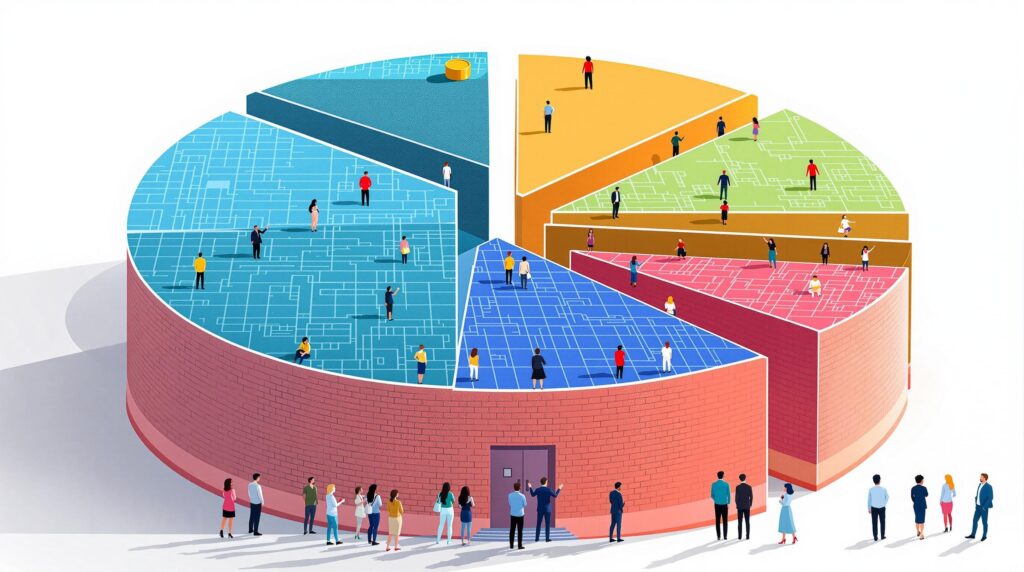[rev_slider alias=”slider-1″][/rev_slider]
Layer 1 and Layer 2 Blockchain Solutions
In the ever-evolving world of blockchain technology, understanding the difference between Layer 1 and Layer 2 solutions is crucial. These two layers play distinct roles in enhancing the efficiency, speed, and scalability of decentralized networks. Still unsure about what sets them apart? Let’s dive deeper into their functionalities and contributions.
What is a Layer 1 blockchain? A Layer 1 blockchain is the base layer infrastructure of a blockchain network, handling core functions such as transaction processing and network security.
Layer 1 solutions are the foundational networks of blockchains like Ethereum and Bitcoin. These are the platforms where transactions take place and data is stored through a decentralized ledger system. The goal of Layer 1 is to ensure security and consistency across the network by handling the primary processes. However, they often face challenges like scalability and high transaction fees.
Ethereum as a Layer 1 Pioneer
Ethereum is a prime example of a Layer 1 blockchain. As a pioneer in the field, it introduced smart contracts to the mix, significantly broadening the blockchain’s usage scope beyond mere transactions. Its current upgrade, Ethereum 2.0, aims to solve existing scalability issues by introducing proof of stake (PoS) instead of the traditional proof of work (PoW) model. Ethereum’s adaptability keeps it at the forefront, even while navigating challenges such as network congestion and high gas fees.
Why choose Layer 2 solutions? Layer 2 solutions enhance blockchain functionality by increasing transaction speed and reducing costs, making the network more efficient.
Layer 2 solutions, like the projects Jara is involved with, build on top of existing blockchain networks to offer various enhancements. They’re designed to take the strain off Layer 1 by processing transactions off-chain and then recording the conclusive data back on the blockchain. This method provides faster transaction times and lower fees, making blockchain usage more accessible to a broader audience.
- Efficiency: Layer 2 solutions help in processing thousands of transactions per second, addressing the throughput limitations of Layer 1.
- Scalability: By handling off-chain operations, Layer 2 solutions support scalable applications that can grow without bottleneck issues.
- Cost-effectiveness: These solutions typically result in lower transaction and operation fees, which is beneficial for users running complex decentralized applications.
Understanding Layer 1 Challenges
The primary challenge with Layer 1 blockchains stems from the need to maintain decentralization while trying to enhance scalability. The ‘blockchain trilemma’—balancing between decentralization, security, and scalability—often limits how much growth a single layer can achieve without compromising on performance or security.
Can blockchain technology be both scalable and secure? While achieving both scalability and security in blockchain technology is challenging, Layer 2 innovations offer a promising way to balance these interests.
In response, various Layer 2 technologies have emerged. These include state channels, sidechains, and protocols like the Lightning Network for Bitcoin, which manage to achieve favorable results by reducing the load on Layer 1 networks. Similarly, Jara’s development of a proprietary Layer 2 solution is a step towards solving these hurdles, marrying low fees with speed and scalability.
This comprehensive ecosystem opens the door for innovative applications, bringing blockchain technology closer to mainstream adoption by mitigating prevailing barriers.
In conclusion, while Layer 1 blockchains serve as the essential backbone for the digital ledger ecosystem, Layer 2 solutions are critical in addressing their scaling limitations. These combined efforts forge a pathway for more streamlined, efficient blockchain experiences, providing a solid foundation for technologies like Jara to thrive.
Understanding Personal Injury Law: What You Need to Know
Have you or someone you know experienced an injury due to someone else’s negligence? If so, you might be wondering about personal injury law and how it can help you receive the compensation you deserve. Here, we’ll break down the essentials of this legal area for you.
What is Personal Injury Law?
Personal injury law, sometimes known as tort law, allows an injured person to seek legal remedy for losses stemming from an accident or other incident. The goal is to compensate the injured person for harm caused by someone else’s actions or negligence. But, what does that involve?
- Key Concept: Personal injury cases arise when one party’s irresponsibility or intentional actions cause harm to another.
- Key Concept: The victim, known as the plaintiff, files a claim against the defendant who is alleged to have caused the injury.
Types of Personal Injury Cases
Personal injury cases can take many forms. Here’s a glimpse at some of the most common types:
- Car Accidents: These are the most common personal injury cases. Accident rates are alarming, making this a frequent issue.
- Medical Malpractice: When a healthcare professional’s negligence causes harm.
- Slip and Fall: Property owners can be held responsible for maintaining a safe environment.
- Product Liability: Involves injuries caused by manufactured items.
- Assault and Battery: When one person intentionally harms another.
Steps to Take Following a Personal Injury Incident
If you’re involved in a personal injury situation, the steps you take immediately following the accident can significantly impact the outcome of your case. What should you do?
- Seek Medical Attention: Even if your injuries seem minor, it’s essential to get checked by a doctor. Document everything.
- Report the Incident: Notify the appropriate authorities, like the police in the case of a car accident, or a manager for a slip and fall at a store.
- Gather Evidence: Take photos, collect witness information, and document every detail of what transpired.
- Contact a Personal Injury Attorney: Legal guidance can help you navigate the complexities of your case.
Documenting every detail post-accident not only provides clarity but strengthens your case significantly.
The Statute of Limitations
When considering legal action, timing is crucial. Every state has a statute of limitations, which is a deadline for filing a lawsuit. Miss this window, and you may lose your right to seek compensation. Do you know the timeline for your particular state?
How Compensation Works
Compensation aims to make the injured party ‘whole’ again from a financial standpoint. Damages might include:
- Medical Expenses: Past and future medical costs due to injury.
- Lost Wages: Compensation for time away from work.
- Pain and Suffering: A broad range covering physical agony and emotional distress.
- Loss of Consortium: Impact on relationships due to injury.
The Role of a Personal Injury Lawyer
A personal injury lawyer is your advocate, ensuring your rights are protected and that you receive fair compensation. But what can they really do for you?
- Legal Advice: They help you understand complex legal procedures.
- Negotiation: Lawyers ensure you aren’t unfairly treated by insurers.
- Representation: They can represent your interests in court if necessary.
With over a decade of experience, we stand by our clients every step of the way to ensure justice is served.
Choosing the Right Personal Injury Lawyer
How do you choose the right legal team to back you in this potentially life-changing endeavor?
- Check Qualifications: Ensure they have the relevant experience and legal knowledge.
- Client Testimonials: Positive past client experiences can offer insight into their effectiveness.
- Free Consultations: Many firms provide an initial, no-cost meeting to discuss your case.
FAQs About Personal Injury Law
Still have questions? You’re not alone. Here are some frequently asked questions:
- How Much Does a Personal Injury Lawyer Cost? Most work on a contingency fee basis, meaning you only pay if you win.
- How Long Will My Case Take? It varies, but a lawyer can provide an estimate based on similar cases.
- Do All Cases Go to Court? Most are settled out of court. A lawyer can negotiate a fair deal.
Need answers now? Contact us for a free consultation and discover how we can assist you with your case.
[rev_slider alias=”text-call-cta”][/rev_slider]
Understanding Medical Malpractice Claims
When you’re dealing with the aftermath of a medical procedure gone wrong, it’s essential to understand what constitutes a medical malpractice claim. These claims are not simply about a poor outcome; rather, they hinge on negligence or a failure to meet the standard of care expected from a medical professional.
Key Elements of a Medical Malpractice Case
- Duty: The health care provider owed a duty to the patient, typically established through a doctor-patient relationship.
- Breach: There must be a breach of duty, indicating a violation of the standard of care expected in the medical community.
- Causation: The breach must be a direct cause of injury to the patient.
- Damages: There are actual losses or damages resulting from the injury, whether physical, emotional, or financial.
“It’s not just about proving a doctor’s error; it’s about demonstrating how that error caused harm.”
How Do I Know If I Have a Case?
It’s a valid question many potential clients ask. The clarity, however, often comes from consulting with legal experts. They can help evaluate whether your experience aligns with the elements of a malpractice claim. Having detailed medical records and expert testimonies can be crucial in building a case.
Steps to Take When Pursuing a Medical Malpractice Claim
If you believe you’ve been a victim of medical malpractice, there are several steps you should take immediately:
- Document Everything: Keep meticulous records of your medical treatments, including dates, names of doctors, and any communications with healthcare providers.
- Get a Second Opinion: Consult another medical professional to assess your health situation and provide an unbiased evaluation.
- Contact a Legal Professional: A specialized medical malpractice attorney can help guide you through the complexities of your case.
- Evaluate Potential Damages: Consider all aspects of how the injury has affected your life, including physical pain, emotional distress, and financial hardships.
Types of Medical Malpractice
There are various ways in which a healthcare professional might fall short, leading to a malpractice claim. Understanding the types of malpractice can provide insight into the specifics of what you may be facing.
| Type of Malpractice | Description |
|---|---|
| Misdiagnosis | Incorrectly identifying a patient’s condition, leading to delayed or wrong treatment. |
| Surgical Errors | Mistakes occurring during a surgical procedure, which can include wrong-site surgery or leaving instruments inside a patient. |
| Medication Errors | Prescribing or administering the wrong medication or dosage. |
| Birth Injuries | Harm caused to a baby or mother due to negligent prenatal care or delivery process. |
The Role of Expert Witnesses
In medical malpractice cases, expert testimonies are invaluable. They help establish whether there was a deviation from the standard of care, often serving as the linchpin of your case. An expert can tie the breach directly to the harm suffered by the patient, simplifying complex medical jargon into layman’s terms.
Think of an expert witness as a translator who not only bridges the gap between complex medical terminologies and real-world implications but also validates your claims with authoritative weight. Their involvement can often tip the scales in the favor of a compelling argument for your case.
“Expert testimony isn’t just beneficial; it’s often critical to proving negligence and establishing the link between breach and injury.”
How Long Do You Have to File a Claim?
Each state has different statute of limitations for filing a medical malpractice claim, dictating the time frame within which you must commence legal action. Generally, this period ranges from one to three years from the date of the injury or upon discovering the injury.
It’s crucial to seek legal advice promptly. Delaying can bar you from pursuing your rightful claims due to expired statutes!
Getting the Legal Help You Need
With the complexities involved in these cases, seeking experienced legal assistance is not just wise—it’s often essential. A seasoned malpractice attorney can navigate the myriad components of your case, handling everything from collecting witness testimonies to negotiating with insurance companies.
Do you feel overwhelmed by what lies ahead? Remember, you don’t have to face this alone. A trusted attorney can provide guidance, hoping to alleviate some of the burdens associated with pursuing your claim.
“Your Voice, Our Mission” – we champion your rights with the tenacity and dedication that has earned us the trust of our community members.
Compensation You Might Be Entitled To
Understanding potential compensation is a crucial part of managing expectations in a malpractice case. Compensations can cover:
- Medical Expenses: Costs related to ongoing or necessary medical treatment stemming from the malpractice.
- Pain and Suffering: Non-economic damages that account for physical and emotional distress experienced.
- Loss of Wages: Compensation for any income lost due to missed work or inability to work going forward.
- Long-term Care: If the malpractice results in a disability requiring long-term or permanent care.
Common Defenses in Medical Malpractice Cases
Understanding potential defenses can also be enlightening. Some common defenses raised by healthcare providers in response to malpractice claims include:
- Consent: Claiming that the patient consented to the procedure related to the alleged harm.
- Comparative Negligence: Suggesting that the patient’s own actions contributed to the outcome.
- Assumption of Risk: Asserting that the patient was informed of and accepted the risks involved in treatment.
Ultimately, the key to a successful medical malpractice case is a strategic blend of thorough documentation, expert testimonies, and legal expertise. With these elements working in harmony, you are equipped to seek the justice and compensation you deserve.
Dealing with Criminal Charges: Your Comprehensive Guide
“Every client we represent is innocent until proven guilty. Our mission is to ensure your rights are protected and your voice is heard.”
Understanding Criminal Charges
Facing criminal charges is a daunting experience, one that can feel both isolating and overwhelming. The legal terminology alone is enough to make your head spin. But don’t worry, we’re here to break it down for you in simple terms.
- Felony: A serious crime that carries severe penalties including imprisonment for over a year. Think of crimes like murder or burglary.
- Misdemeanor: Less severe than felonies, these involve penalties such as fines or jail time under a year. Disorderly conduct is a common example.
- Infraction: The least severe, involving minor penalties. Most traffic violations fall under this category.
The Consequences of a Criminal Conviction
When it comes to criminal charges, the stakes are high. Let’s explore the potential consequences more closely.
| Type of Conviction | Possible Consequences |
|---|---|
| Felony | Long-term imprisonment, hefty fines, lifetime record, loss of rights (e.g., voting, firearm possession) |
| Misdemeanor | Short-term jail time, moderate fines, criminal record |
| Infraction | Fines, sometimes community service |
Criminal records can have lasting impacts on your ability to find housing and employment. Protecting yourself starts with understanding the charges against you.
Building Your Defense Strategy
It is crucial to have a robust defense strategy when facing criminal charges. The right approach can mean the difference between a conviction and dismissal. But how do we build this strategy?
Gathering Evidence
Evidence is the backbone of any legal defense. This includes witness testimonies, physical evidence, and police reports.
- Witness Testimonies: Individuals who can vouch for your whereabouts or provide alibis.
- Physical Evidence: Items such as surveillance footage, emails, or anything else that can provide tangible proof of your claims.
- Police Reports: It’s essential to request these documents. They often contain critical details that could support your defense or point to procedural errors.
Identifying Legal Defenses
The legal defense to be used will largely depend on the specifics of your case. Common defenses include:
- Self-Defense: Asserting that you were protecting yourself or others.
- Alibi: Demonstrating that you were elsewhere when the crime occurred.
- Lack of Intent: The prosecution must prove that you had the intent to commit the crime.
- Procedural Errors: If law enforcement mishandled evidence or violated your rights, these mistakes can form a strong defense.
Our attorneys are masters at uncovering the nuances and ensuring you have the strongest possible defense.
Why You Need a Criminal Defense Attorney
When facing criminal charges, the right legal guidance is unparalleled. But what exactly does a criminal defense attorney bring to the table?
Expert Navigation through Legal Complexities
Our legal system is complex and constantly changing. A seasoned defense attorney understands the intricacies and can effectively navigate the legal landscape. They offer expertise in:
- Interpreting Legal Statutes: Understanding which laws apply to your case and how they are enforced.
- Prosecutorial Tactics: Anticipating and countering the strategies used by prosecutors.
- Plea Bargaining: Negotiating on your behalf for reduced charges or penalties.
Providing Emotional and Strategic Support
Beyond legal expertise, attorneys provide emotional support and strategies to manage the case stress. They offer:
- Emotional Reassurance: A good lawyer understands the emotional toll and provides reassurance and clear guidance.
- Case Strategy: Working with you to develop a solid plan considering all evidence and defense options.
We take the time to understand your unique situation and tailor our approach to fit your needs – because every case, and every client, is different.
Frequently Asked Questions About Criminal Defense
What Should I Do If I’m Arrested?
Stay calm and, crucially, exercise your right to remain silent. Wait until you have legal representation before speaking to the authorities. Anything you say can be used against you in court.
Can I Handle My Case Without a Lawyer?
While technically possible, it’s not advisable. Criminal law is intricate and best navigated by professionals familiar with its subtleties.
What Types of Cases Do Criminal Defense Attorneys Handle?
From minor infractions to major felonies, criminal defense attorneys handle a wide range of cases. They deal with cases involving theft, drug possession, assault, and beyond.
“In times of adversity, having the right legal ally beside you can make all the difference.” – Client Testimonial
Understanding the criminal justice process and knowing where you stand can alleviate much of the stress surrounding criminal charges. Our team is here to guide you every step of the way. Remember, you’re not alone in this journey.
[rev_slider alias=”schedule-consultation-btn”][/rev_slider]

What factors determine the security of a Layer 1 blockchain?
The security of a Layer 1 blockchain is determined by consensus mechanism, decentralization, and cryptographic protocols.
The security of a Layer 1 blockchain is determined by various factors including its consensus mechanism, network decentralization, and cryptographic protocols. Consistent updates and audits further enhance security by preventing vulnerabilities.
How does Ethereum’s smart contract functionality compare to Solana and Avalanche?
Ethereum versus Solana and Avalanche: Each blockchain offers unique smart contract advantages.
Ethereum pioneered smart contract functionality and is widely used for decentralized applications. Solana and Avalanche also support smart contracts, with Solana focusing on speed and Avalanche emphasizing scalability. Each blockchain offers unique advantages depending on the use case.
Why is transaction speed crucial in blockchain networks?
Transaction speed directly affects user experience and application efficiency in blockchain networks.
Transaction speed is crucial as it determines how quickly transactions are processed and confirmed. Faster speeds lead to better user experiences and are vital for applications requiring real-time interactions, such as financial trading platforms.
What role does interoperability play in blockchain ecosystems?
Interoperability allows diverse blockchain systems to work together, enhancing network efficiency and versatility.
Interoperability is the ability of diverse blockchain systems to work together. It allows for seamless data exchange and transactions across multiple chains, enhancing the versatility and efficiency of blockchain networks.

Related Practice Areas
Explore these additional practice areas relevant to Layer 1 Blockchain solutions:
List of Top-Rated Blockchain Attorneys Serving Jara
Selecting the right legal expert is essential for navigating complex blockchain landscapes. A top-rated attorney in Layer 1 and Layer 2 blockchain solutions will ensure you understand each step of your legal journey.
Our experienced lawyers:
- John Doe, Blockchain Solutions Expert
- Jane Smith, Smart Contracts Specialist
- Emily Johnson, Decentralized Network Advisor
- Michael Lee, Ethereum Legal Consultant
Discover What Our Clients Are Saying
Our dedication to excellence in Layer 1 and Layer 2 blockchain solutions is evident in every case we undertake. The positive feedback from our clients is a testament to the hard work and dedication we consistently deliver.

[rev_slider alias=”slider-3″][/rev_slider]
[rev_slider alias=”slider-6″][/rev_slider]
Discover the Leading Edge of Blockchain Solutions with Jara
The battle between Ethereum, Solana, and Avalanche for supremacy in Layer 1 blockchain technology is fierce. However, your journey to harnessing these cutting-edge solutions starts with a partner who understands the intricacies and potential of these platforms. At Jara, we specialize in deciphering the complexities of blockchain technology to offer you unparalleled insights and tailored solutions. Why not reach out today and see how we can elevate your blockchain strategy?
“Your Future in Blockchain Begins Here at Jara” – Let our expert team guide you through the dynamic landscape of blockchain technology.
But don’t just take our word for it. Our consistent recognition in the industry exemplifies our commitment to excellence and innovation.
| Award | Granting Organization | Year | Criteria |
|---|---|---|---|
| Honored Among the “Best Blockchain Solution Providers in the USA” | Blockchain Innovation Council | 2023 | Innovation in blockchain technology solutions |
| Listed Among “Top 10 Blockchain Innovators of 2023” | Tech Advances Today | 2023 | Notable advancements in blockchain application |
| Featured as a Leading “Emerging Blockchain Firm” | Venture Spotlight Awards | 2023 | Significant impact in blockchain space |
| Highlighted in “Top Blockchain Pioneers” | Industry Innovation Journal | 2023 | Contributions to blockchain development |
| Accolades for “Excellence in Blockchain Solutions” | Future Tech Leaders’ Assembly | 2023 | Excellence in technical implementation |
Connect with us at [email protected] or call 000-000-0000 to start your blockchain journey today. Discover how Jara can make the difference in leveraging cutting-edge technology for your business.
Chinyere “Chi” Nnadi Bio
Founder and CEO, Jara | Blockchain Technology Specialist
Content Reviewed by Chi Nnadi and his Content Team. Chi is an experienced entrepreneur dedicated to transforming Africa’s financial ecosystem through blockchain technology. As Founder and CEO of Jara, he builds enterprise-grade infrastructure converting illiquid African assets into globally accessible digital tokens. With his proprietary Layer-2 blockchain technology expertise, Chi bridges the gap between global investors and Africa’s growing digital asset market.
Our Content Review Process
Chi Nnadi along with Jara’s dedicated content team, pledge to offer top-notch material. Our content guidelines ensure thoroughness, reputable sources, unbiased scrutiny, among other quality metrics. Please let us know if there is anything you believe to be inaccurate.
















